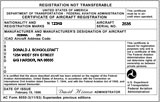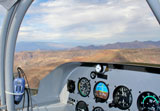|
Special Flight PermitGeneral InformationA special flight permit is issued for an aircraft that currently may not meet applicable airworthiness requirements, but is capable of safe flight. FAR 21.197 is the regulation that applies to the issuance of a special flight permit (special airworthiness certificate). FAR 21.197(a) applies to aircraft that may not meet applicable airworthiness requirements and that will be operated for a purpose specified in FAR 21.197(a)(1) through (5). FAR 21.197(b) applies to those aircraft that meet all of the applicable airworthiness requirements except those that cannot be met because of an overweight condition. FAR 21.197(c) applies only to holders of operating certificates issued under FAR 121 or 135 for aircraft operated and maintained under a continuous airworthiness maintenance program. These certificates FAR 121 or FAR 135 certificate holders who do not have a continuous ferry authorization. This normally will be issued by their certificate holding district office (CHDO). However, with the CHDO’s concurrence, these special flight permits may be issued by another office having geographical responsibility for the area the aircraft is located in. Under special conditions, a special airworthiness certificate may be issued to FAR 145 repair facilities for the purpose of delivering aircraft from international locations to the United States. In this instance, the permit will be issued by the FAA office having jurisdiction over the repair facility under the following conditions: 1. It is a U.S.-registered aircraft that currently does not meet the conditions of its standard airworthiness certificate, due to the installation of non-standard auxiliary fuel systems. Auxiliary fuel system installations must be accomplished by an FAA-certificated repair facility which is specifically airframe-rated for the desired installation. 2. Procedures relating to the application and issuance of special airworthiness certificates, the installation of auxiliary fuel systems, and any conditions and limitations for flight must be incorporated into the repair facility’s operations specifications. The validity of the special airworthiness certificate is not affected by the operation of the aircraft outside the border of the United States, as long as it is operated for the intended purpose under FAR 21.197 and within the timeframe specified on the permit. The special airworthiness certificate does not authorize flight over countries other than the United States without permission of that country. If such operation is contemplated, the effective date of the permit is contingent on compliance with section D(2) of the permit and it becomes the responsibility of the owner/operator to obtain such permission. In accordance with FAR 39.7, anyone who operates a product that does not meet the requirements of an applicable AD is in violation of this section. If an AD requires compliance before further flight and has within it a provision that does not allow for any special flight permit, a special airworthiness certificate will not be issued for the product. An aircraft can be ferried to a place where an airworthiness directive can be complied with as authorized in FAR 39.23. If the engineer determines that the aircraft cannot be moved safely, the AD will include a paragraph that does not allow a special airworthiness certificate to be issued or may have certain restrictions about the issuance. The FAA/DAR also has the authority under FAR 39.23 to deny a special flight permit request for safety reasons as well as adding operating restrictions to the proposed route of flight. An example of a justified denial would be a special flight permit request for operation over large bodies of water or mountainous terrain with a single-engine aircraft that has an AD applicable to the engine or propeller. If the product is not an aircraft, and the AD does not provide for the product’s operation during a ferry flight, in accordance with FAR 39.7 the product may not be operated during such a flight. If the aircraft on which the product is installed can be operated safely without operating the product, a special flight permit could be issued in accordance with FAR 21.197(a) with a limitation that the product be rendered inoperative for flight. PurposesFAR 21.197 prescribes the general purposes for which a special flight permit may be issued. The following specific operations also are considered to be within the scope of the general provisions: - Any flight of a U.S.-registered aircraft covered by FAR 21.197, if the aircraft is capable of safe flight, even though a Type Certificate (TC) has not been issued. - The delivery of an aircraft of either U.S. or non-U.S. manufacture to the base of the purchaser or to a storage point in the United States. - The operation of non-air carrier four-engine aircraft with one inoperative engine. The provisions of FAR 91.611 should be used as a guide. - Flying an aircraft whose annual inspection has expired to a base where an annual inspection can be accomplished. - Flying an amateur-built aircraft whose condition inspection has expired to a base where the condition inspection can be accomplished. - Production flight testing of LSA in accordance with FAR 21.190(c)(7). Application and IssuanceWhen the application for a special flight permit is found in compliance with all requirements, the FAA will issue a special airworthiness certificate (Form 8130-7), with operating limitations deemed necessary for safe operation. The operating limitations will be enumerated on a separate sheet, identified by the aircraft registration and serial number, dated, and signed. The applicant should be advised that Form 8130-7 and attached operating limitations must be displayed in the aircraft in accordance with FAR 91.203(b). The FAA may assist the applicant by completing the application Form 8130-6 based on information furnished by telephone, letter, or fax. The name of the applicant should be entered in the space provided for the applicant’s signature. A notation as to how the information was received should be entered above the name, for example, “Received by letter dated .” If the information provided is adequate, and all requirements for issuance are satisfied, the FAA Aviation Safety Inspector (ASI) may issue a telegraphic or faxed special flight permit with appropriate limitations (except FAR 21.197(b) for overweight operations). These limitations will include inspection requirements as deemed necessary. The telegraphic or faxed copy of the specialflight permit and prescribed operating limitations must be displayed in the aircraft in accordance with FAR 91.203(b) prior to conducting the special flight. NOTE: FAA DAR's cannot issue a telegraphic or faxed special flight permit and are required to physically performthe inspection necessary to ensure the aircraft is eligible for the special flight permit. If a district office processes numerous applications for telegraphic or faxed special flight permits, a standard format may be filed with the local office. When Form 8130-6 has been completed, the ASI will complete the telegraphic or faxed special flight permit to include any additional operating limitations that may be required. The completed and signed permit may then be transmitted by fax. The faxed copy of the permit that is received for display in the aircraft at the point of departure will be considered the original permit. Aircraft InspectionsIt is the responsibility of the FAA/DAR to determine which inspections or tests are necessary to ensure that the aircraft is capable of safe flight for the intended purpose. The FAA/DAR will make, or require the applicant to make, appropriate inspections or tests considered necessary for safe flight. The FAA/DAR will personally inspect damaged aircraft or an aircraft for which the airworthiness is questionable in any respect. They will personally inspect those aircraft models for which a U.S. TC has never been issued. The FAA/DAR is authorized, at its discretion, to allow a properly certificated mechanic or a repair station to conduct the necessary aircraft inspection(s) in support of the issuance of a special flight permit. NOTE: If an affirmative, technical determination cannot be made that a particular aircraft is capable of safe operation because of insufficient design, inspection, or maintenance data that normally is available for a type-certificated aircraft, the special flight permit will not be issued. When the FAA requires the applicant to make the inspection, the applicant will be advised that such inspections must be - - Accomplished by an appropriately certificated mechanic or repair station familiar with all of the procedures and requirements outlined by the FAA/DAR. - Documented in the aircraft logbook by the authorized person who conducted the inspection. Special Operating LimitationsThe FAA/DAR will establish limitations as deemed necessary for safe operation. Because individual circumstances may vary greatly, a list of limitations applicable in every case cannot be provided. The objective is to ensure safe operation of the aircraft. If necessary, solicit the technical assistance of other FAA offices or specialties. Limitations will be clear and concise so they can be easily understood. In addition to the limitations deemed necessary for the particular flight, the following items will be considered when establishing operating limitations: - Conformity to the aircraft’s technical data. - Operational equipment necessary for safe operation of the aircraft. - Special qualifications required of the pilot and crewmembers. For flights that involve long distances over which various weather conditions may be encountered, the pilot in command also must be appropriately instrument-rated. - Aircraft weight limits. - Fuel and fuel distribution limits. - CG limits. - Maneuvers to which the aircraft is limited. - Limits on use of flight equipment, such as autopilots, etc. - Meteorological conditions to be avoided and the inspections required if inadvertently encountered. - Airspeed limits. - Operation in the overweight condition must be conducted to avoid cities, towns, villages, and congested areas, or any other areas where the flights might create hazardous exposure to persons or property. - Runway selections, if considered necessary for safety. - Communications required with airport tower personnel to inform them prior to takeoff or landing of the nonstandard condition of the aircraft. - When flight over another country is planned, the FAA/DAR will emphasize to the applicant that special permission must be obtained from the country over which the aircraft will be operated. In addition, section C of Form 8130-7 will contain the statement, “Subject to D(2) on reverse side.” NOTE: When required to fly over an ICAO country, the operating limitations issued with the special flight permit will include, when appropriate, the following statement: “This aircraft does not comply with the international standards of Annex 8 to the Convention on International Civil Aviation as follows: (The item(s) which do not comply with the airworthiness requirements for standard aircraft will be listed).” - Any other limitation that should be prescribed for the particular flight. Click on the following links for specific information related to those topics:
Go from this Special Flight Permit Page back to the Aircraft Certification List |









